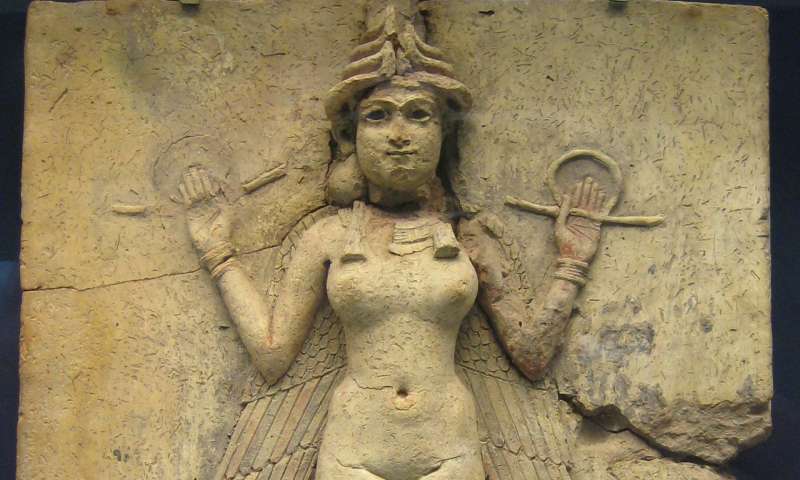The idea of gods shaking heaven and earth is not only found in the Bible (the words of the prophets and psalms) but is fairly common amongst most people of the ancient near east – including what is now Iraq – see https://phys.org/print443688956.html … It is common to Enlil and Ninlil, Enki and Ninhursag for example, and more or less concerns trickery, shape shifting, disguise, and deception. As the consort of Yahweh is absent from the Bible as it now stands one has to wonder if the same thing applies to ancient Israel – but see William Dever's book. 'Did God have a wife: archaeology and folk religion in ancient Israel' Grand Rapids:2005. He came to the conclusion the goddess Asherah was formerly the consort of Yahweh. Dever was scholarly in his book but this link appears to have a purposefully attention grabbing focus – sex amongst the gods. This subject may stir interest in the West – but was there anything about the subject that the ancients would see as histrionic?
 … Goddesses also seduced kings we are told, pointing to Gilgamesh (who was probably a god initially and the name of a king much later). Ishtar is said to have sexually stirred the emotions of Gilgamesh, for example, and she was the sister of Erichkigal the consort of Nergal. This is a known dimension of mythology and even the Irish tales concerning the Dagda involve sexual encounters with goddesses – but what does it all mean? Inanna, another form of Ishtar (the same god with a different name) was the focus of research published in SIS journals so members are well aware of some of the activities of each and every one of these gods and goddesses. The lover of Inanna was Dumuzi, a shepherd in the sky, and the tale is full of sensuous strings of words describing their encounters. We may compare this with the Biblical 'Song of Solomon' where the queen of Sheba substitutes for the goddess, actually replacing her even where it seems that it does not involve people but gods (Solomon representing the Jebusite god of Jerusalem, Shalman). What we might thus make of the queen of Sheba in that context is something else but in all likelihood the song is an addition to the Bible via the folklore of Jerusalem (which was still potent even as late as the early Islamic period). The song also has an explicit act of sex – although this is denied by devout believers.
… Goddesses also seduced kings we are told, pointing to Gilgamesh (who was probably a god initially and the name of a king much later). Ishtar is said to have sexually stirred the emotions of Gilgamesh, for example, and she was the sister of Erichkigal the consort of Nergal. This is a known dimension of mythology and even the Irish tales concerning the Dagda involve sexual encounters with goddesses – but what does it all mean? Inanna, another form of Ishtar (the same god with a different name) was the focus of research published in SIS journals so members are well aware of some of the activities of each and every one of these gods and goddesses. The lover of Inanna was Dumuzi, a shepherd in the sky, and the tale is full of sensuous strings of words describing their encounters. We may compare this with the Biblical 'Song of Solomon' where the queen of Sheba substitutes for the goddess, actually replacing her even where it seems that it does not involve people but gods (Solomon representing the Jebusite god of Jerusalem, Shalman). What we might thus make of the queen of Sheba in that context is something else but in all likelihood the song is an addition to the Bible via the folklore of Jerusalem (which was still potent even as late as the early Islamic period). The song also has an explicit act of sex – although this is denied by devout believers.
This aspect of the gods has been looked at by catastrophists over the years and various theories have been aired. Plasma phenomena may have given rise to shape shifting and disguise (in the stories of the gods as well as in folklore) – a pulsating purple auroral display may have been interpreted as the fluttering wings of a purple butterfly (a feature of Celtic myth for example). One other idea of the union of male and female gods is a connection with comets (assuming people witnessed a comet coming close enough to earth) is the intense activity generated between the nucleus (the female element) and the coma (the ion tail). Stories of the gods were set in a human dimension – which is where white and black characters in folklore may originate. White because comets are that colour at a distance and black because comet nucleus are jet black when seen up close (as spacecraft have shown in recent years). All speculation of course but ideas you won't see aired in mainstream quarters. The article does not dwell too much on the actual shaking of the earth – assuming it was a virulent act of sex and nothing more. The shaking of the earth is reminiscent of not just earthquakes – but extraordinary earthquakes, or even worse.
